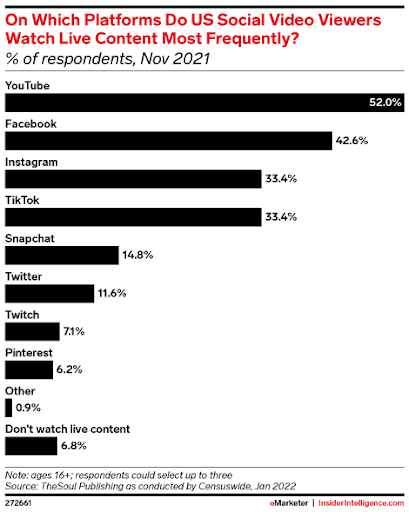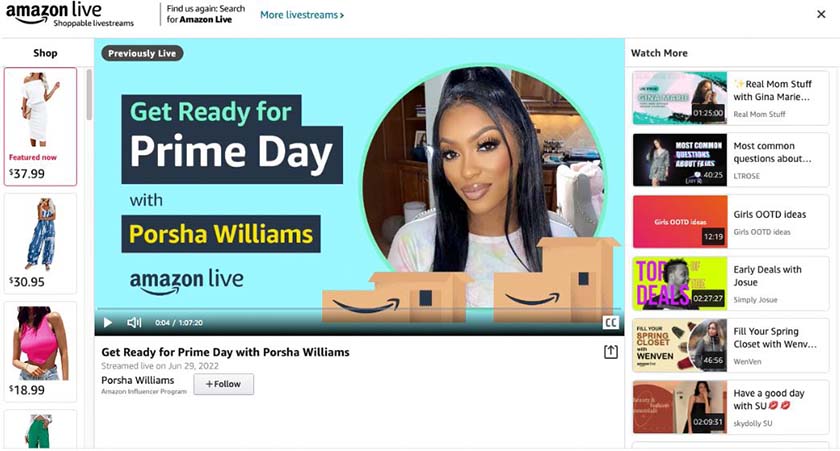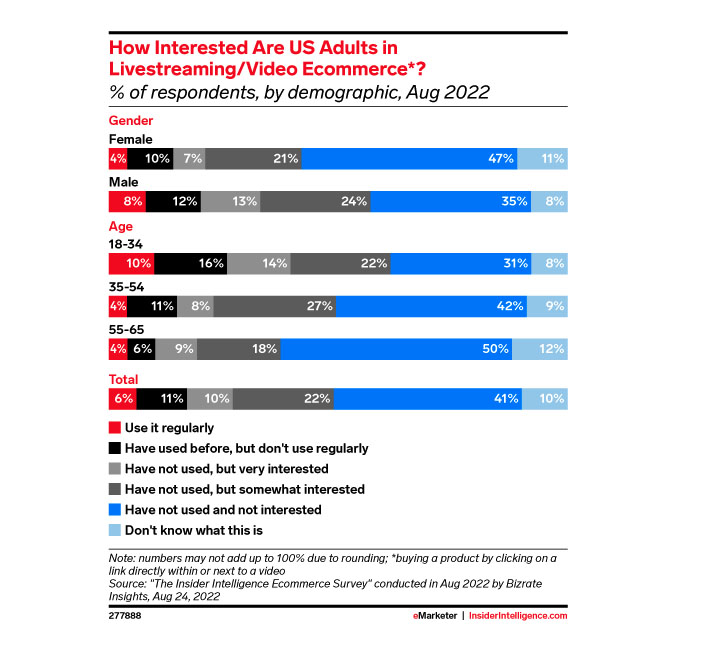Livestream shopping, also known as live shopping/live commerce, is a marketing technique in which businesses hold live shopping events online—via Facebook, YouTube, or Instagram—to showcase and sell their products. Viewers can see the products in action, ask questions during the event, and ultimately purchase items in real time.
This article will take a look at the most significant livestream shopping statistics and trends, so your business can take advantage of this growing and powerful selling channel.
Key takeaways:
- Companies that offer livestream shopping report conversion rates up to 30%—10x higher than traditional ecommerce.
- 83% of Gen Z consumers have used livestream shopping.
- 23% of ecommerce livestream viewers buy products during the livestream, 34% make a purchase after the livestream event, and 35% begin following the brand or host on social media.
US Industry Trends
The livestream shopping industry is expanding into US markets at an impressive clip, boasting high conversion rates and a growing foothold in the fashion industry. But, whereas livestream shopping has been around a bit longer and has garnered more trust in Asian markets, American consumers are still a bit skeptical of the new medium.
1. The US livestream shopping market is estimated to be worth $68 billion by 2026
A key trends report from Coresight Research and Bambuser estimated the value of US livestream shopping hit $32 billion in 2023. That number will more than double to about $68 billion by 2026 and make up more than 5% of total ecommerce sales.
2. Livestream shopping app installation jumped 77% in the first half of 2022
The top 10 live shopping apps grew 77% year-over-year in the first five months of 2022, with some 2.3 million installs, according to data from Sensor Tower. Those apps include QVC, NTWRK, and Whatnot.
3. Clothing is the top-purchased category for livestream shopping in the US
While China boasts groceries as the most-purchased shopping category for livestream shopping, according to a McKinsey study from 2022, US consumers, along with Europe and Latin America, most often purchase clothing at live shopping events. About 43% of livestream purchases fall into the clothing category for US consumers, followed by skin care at 32%, accessories at 31%, and body care at 31%.
4. Facebook is the most popular live shopping platform in the US
According to Coresight Research, Facebook is the most popular livestream shopping platform among US retailers, with 55% of businesses using the platform in 2022. YouTube is right behind at 52%, with Instagram taking the third spot.
5. YouTube is the most frequently used platform for platforms to watch lives
While live commerce is common on Facebook and Instagram, viewers watch livestreams on YouTube than any other platform (52% compared to 42.6% for Facebook and 33.4% for both Instagram and TikTok), according to eMarketer. Consider meeting your consumers where they’re already acclimated and partaking in live video.

Source: eMarketer
6. Companies report live commerce conversion rates are up to 10x higher than conventional ecommerce
With the ecommerce retail market more saturated and competitive than ever, companies that use live commerce strategies are seeing conversion rates of up to 30%, according to McKinsey research. That is 10 times higher than the average ecommerce conversion rate.
7. Livestream shopping has been a selling strategy in the luxury goods industry the longest
Luxury goods retailers have been livestreaming the longest. Thirty percent of luxury retailers that use livestream shopping have been using the strategy for more than two years, per Coresight Research. That compares to about 20% or less for businesses in other markets (such as apparel, beauty, grocery, and electronics).
Retailer Insights
Retail businesses are optimistic about livestream shopping and see it as an important part of the future of retail. From higher conversion rates to deeper customer insights and connections, retailers that engage in live commerce can gain a lot.
8. Live shopping is one of the top 8 digital commerce channels for retailers
According to WARC, livestream commerce has a purchase incidence rate of more than 30%. Although that’s significantly below online marketplaces and retailer websites (both at 70%-plus), it is now within six percentage points of social commerce.
9. Customer engagement and revenue are the top benefits of shoppable livestreaming
Although you might think revenue is the main driver for creating livestream events, livestream shopping statistics show that customer engagement is equally important for North American retailers. Each was called out as a primary benefit by 49% of Coresight Research’s survey respondents.
10. Nearly half of livestreaming retailers expect 10% to 50% livestream channel growth
About 47% retailers that participate in livestream events predict strong growth of 10%–50% over the next two years, with an additional 16% anticipating growth of greater than 50%, per Coresight Research.
Retailers in the beauty, consumer electronics, and general merchandise categories are the most bullish.
11. Retailers use an average of nearly 4 platforms to livestream
According to Coresight Research and Bambuser, proprietary websites, social media, and video-sharing networks are among the 3.9 platforms retailers use for livestreaming. Consumers also use multiple platforms—2.5 on average—to view livestreams.
12. Nearly 30% of livestreaming retailers use their own platform
Retailers’ multi-platform approach to livestreaming, as illustrated by the statistic above, includes using their own website or app. Twenty-eight percent of retailers engaging in livestream events host them on their own platforms alongside more popular social media and video-sharing platforms.
13. Retailers believe educational content is key to influencing livestream viewers
Surveyed retailers said that providing product education during a livestream had the biggest impact on customer behaviors, followed by the livestream topic and offered incentives. Entertainment value was deemed the least impactful.
14. More than half of livestreaming retailers use marketing agencies for promotion
Coresight Research/Bambuser’s survey also revealed that 54% of retailers that produce livestream events use a marketing agency for promotion. Another 50% cross-promote their events with other brands or retailers, and nearly half use content agencies to help produce the livestreams.
Related:
15. 46% of companies have used live data/customer tracking technology during live commerce events
Live data analysis/customer tracking is the top technology used in live shopping, per Coresight Research. Other frequently used technologies include screen sharing with the host and a virtual backdrop or green screen to enhance the viewing experience. Augmented reality/virtual reality and artificial intelligence (AI)-powered hosts also made the list.
16. Livestreaming events during Amazon Prime Day attracted more than 100 million views in 2022
Thousands of brands produced livestream events for Amazon Prime Day 2022. Overall, the events attracted more than 100 million views, with some 57,000 concurrent views at its peak, according to Adweek.

Various celebrities and influencers participated in livestreams for Amazon Prime Day in 2022. (Source: TechCrunch)
Consumer Demographics
So, who exactly is doing all this livestream shopping? Overall, younger consumers embrace this means of shopping more than others. And men tend to be more interested than women. Take a closer look at consumer live shopping statistics.
17. 83% of Gen Z consumers use live shopping
Livestream shopping is more appealing to younger consumers, with Gen Z being the largest demographic that shops via live video content on social media. About 83% of Gen Z consumers do so, and 58% of Millennials also participate in live commerce, according to VTEX research.
18. Consumers under 45 are twice as likely to have purchased during a livestream than those over 45
According to The Influencer Marketing Agency, 44% of US consumers between 19 and 45, on average, have made a purchase during a live shopping event. On the other hand, only 22% of consumers older than 45, on average, have made such a purchase.
19. American men use livestream shopping twice as much as women
Where only 4% of American women say that they use livestream shopping regularly, 8% of men admit to doing so, per eMarketer. Additionally, men are more likely than women to be interested in learning more about livestream shopping, with 13% of men expressing interest compared to 7% of women.

Source: eMarketer
20. Nearly half of male shoppers have used livestream shopping
Men tend to use livestream shopping more than women. About 48% of men say they have shopped this way before, compared to 42% of women, according to VTEX research.
21. 31% of men like to discover new products
When asked why they like livestream shopping in the same study, 31% of men cited being able to discover new products. Another 20% said they would engage in more live commerce, as much as on a daily basis, if brands were to embrace this means of business more widely.
Consumer Insights
So, what do consumers think of this new shopping method? Well, even if there is some skepticism and inertia to overcome to get them to start using it, the consumers that are engaging in livestreams are spending and enjoying the experience. Read more to learn more about how consumers feel about and use livestream shopping events.
22. Nearly half of consumers are interested in live commerce
A little less than half (46%) of consumers have some level of interest in livestream shopping and about a quarter are completely uninterested in livestream shopping events, according to a survey by Agora.
23. 45% of consumers have at least browsed livestream shopping in the past year
Nearly the same amount (45%) of consumers have browsed or purchased via live commerce in the past year, per VTEX.
24. About 45% of consumers have live shopped with an online marketplace
Online marketplaces like Poshmark and Amazon sponsor their own live shopping events. VTEX reveals that 45% of consumers have participated in one of these over the past year.
25. 61% of consumers use social media for livestream shopping
Social video commerce channels including Facebook Live, TikTok Shop, YouTube, and Instagram Reels are rising in popularity. About 61% of consumers have browsed or shopped using these channels in the past year, according to the same study.
26. Almost a quarter of livestream viewers make a purchase during the live show
Coresight Research and Bambuser found that 23% of ecommerce livestream viewers bought products during the livestream. But what happens after a livestream event can be just as important—if not more so. Another 34% of viewers made a purchase after the livestream event, and 35% began following the brand or host on social media.
27. Only 6% of US consumers regularly make purchases at or after livestream shopping events
According to eMarketer research, only 6% of US adults say they regularly purchase products from livestream events, while 17% have ever made a livestream purchase.
28. About half of US consumers have spent between $20 and $100 on livestream shopping in the past three months
Twenty-seven percent of respondents to The Influencer Marketing Agency’s late 2022 survey had spent between $20 and $50 during live commerce events over the previous three months, with another 24% spending between $50 and $100. Only about 10% of respondents said they had spent more than $200.
29. 36% of consumers like live shopping because they can see product demos
Livestream shopping is popular for a number of reasons—one of those being product demos. About 36% of shoppers surveyed by Agora say they like live commerce because they can see how the product is used. About 15% say they like the ability to interact in real-time with the presenter or influencer, and 9% like to interact with other shoppers.
30. 27% of consumers live shop because they get to have real-time interactions
More than a quarter (27%) of shoppers believe the biggest benefit of live commerce is the ability to ask questions about the product and get answers on the spot, according to the same study. Another 21% cite entertainment as the biggest benefit—to them, it makes the chore of shopping more fun.
31. Finding a good deal is a top reason livestream viewers watch events
Coresight Research and Bambuser found that nearly 40% of livestream viewers said they watch shoppable livestreams to find a good deal, followed by 34% who want to discover a new product and 31% who want to learn more about a product they are already aware of. Other reasons for watching these events include connecting with a favorite brand and watching something new.
Meanwhile, Agora found that 23% of respondents like live commerce because of the exclusive deals often only available during livestream shopping events.
32. Livestream viewers expect to see expert reviews and customer testimonials
Reinforcing the idea that education is a key component of a good livestream shopping experience, 47% of consumers who regularly view shoppable events expect to hear from industry experts and customers, per Coresight Research. Other things viewers expect to see include product hacks and insight into the manufacturing process.
33. More than 80% of Gen Zers watch livestreams before 5 p.m.
The younger the consumer, the more likely they are to watch shoppable livestreams earlier in the day, per Coresight Research. For example, 82% of those aged 18–25 watch before 5 p.m. On the other hand, older generations, such as Gen Xers, are much more likely to watch in the evening.
34. Three-fourths of livestream shoppers view an event at least a few times a month
Of regular livestream shopping viewers, about a third watch a few events per week. Nearly 30% watch a few times a month, and 18% watch daily.
35. 55% of consumers would livestream shop if it were more available
Livestream shoppers are more sporadic than other types of shopping. Only 12% use live commerce monthly and 11% multiple times per week. More than half (55%) of those surveyed by VTEX say they would shop via livestream more often if it were more widely and consistently available.
36. 38% of consumers don’t know if their favorite brands offer live commerce
In fact, 38% of shoppers say they don’t even know if the brands they already know and buy from offer any sort of livestream shopping experience, per VTEX.
37. Concerns around social commerce and preference for in-store shopping are the main reasons consumers don’t consider live shopping
A Morning Consult survey found that about 55% of consumers who won’t consider livestream shopping cited both a preference for in-store shopping and a wariness about shopping via social media. Security and trust issues were recurring themes among the responses.
Frequently Asked Questions
Click through the questions below to get answers to some of your most frequently asked questions about livestream shopping trends and statistics.
Livestream shopping is a $32 billion market, with forecasts putting it at $68 billion by 2026. It’s expected to make up more than 5% of total ecommerce sales.
The conversion rate for livestreaming shopping can be up to 30%. This is about ten times higher than traditional ecommerce conversion rates.
Livestream shopping can boost conversion rates, improve customer engagement, enhance customer experience, and ensure that your business is staying on top of emerging retail trends.
You can sell anything on livestream shopping events – from cars to clothes. The product categories that perform the best on livestream events, however, are clothing, groceries, and beauty.
Livestreaming does not have to be expensive, but it can be, depending on how much you invest in your set, your host, marketing the event, and your livestream platform.
Bottom Line
Livestream selling is an up-and-coming sales channel for retailers. While still in its early stages in the US, we have already seen live commerce take rapid leaps in penetrating the retail market in China and several other countries. In the US, there are signs we will soon experience the same phenomenon.
Whether you are opening a new retail business or running a well-established brand, understanding the live shopping statistics we’ve covered above can help you determine how to best take advantage of this growing opportunity.